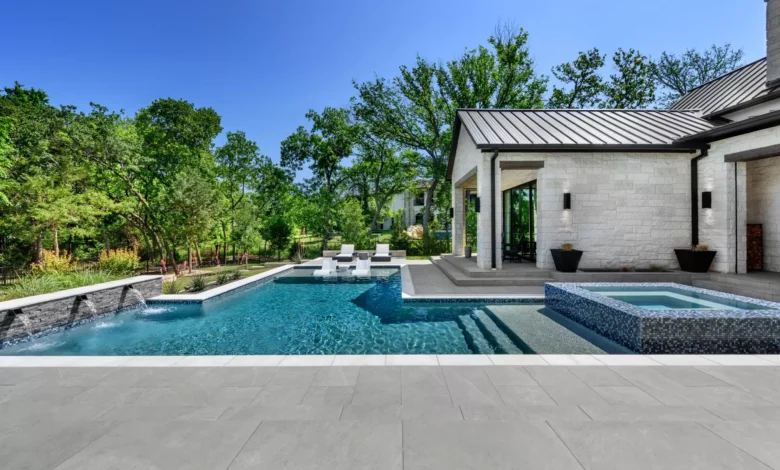Pool Pavers Trends 2025: What’s Popular for Modern Pools?

A well-designed pool area can be the highlight of any outdoor space. One of the key elements in creating a stylish and functional pool area is choosing the right pool pavers. These pavers not only enhance the beauty of your poolside but also provide safety, durability, and comfort.
In this article, we will explore everything you need to know about pool pavers, from their benefits to the selection process and installation steps.
Why Choose Pool Pavers?
Pool pavers are an excellent choice for outdoor pool areas due to their many advantages:
- Slip Resistance – Many pool pavers are designed with textured surfaces to prevent slipping, making them a safer choice around water.
- Heat Resistance – Certain types of pavers, such as travertine and limestone, remain cool underfoot even on hot days.
- Durability – Pool pavers are built to withstand harsh weather conditions, pool chemicals, and heavy foot traffic.
- Easy Maintenance – Pavers require minimal maintenance and can be replaced individually if damaged, saving time and money.
- Aesthetic Appeal – Available in various colors, shapes, and materials, pavers can complement any pool design and landscape.
Types of Pool Pavers
When selecting pool pavers, it’s important to understand the different materials available. Each type offers unique features and benefits:
1. Travertine Pavers
- Natural stone with a luxurious appearance
- Highly porous, making it slip-resistant
- Remains cool underfoot, ideal for hot climates
2. Limestone Pavers
- Elegant and durable
- Offers natural anti-slip properties
- Available in various colors and finishes
3. Concrete Pavers
- Affordable and versatile
- Comes in different shapes and patterns
- Can be sealed for added protection
4. Bluestone Pavers
- Dense and durable natural stone
- Offers a sleek, modern look
- Provides good traction, reducing the risk of slipping
5. Granite Pavers
- Extremely strong and long-lasting
- Resistant to moisture and stains
- Adds a sophisticated touch to poolside areas
6. Brick Pavers
- Classic and timeless appeal
- Durable and slip-resistant
- Can be arranged in creative patterns
How to Choose the Right Pool Pavers
Choosing the right pool pavers depends on several factors, including budget, aesthetics, climate, and maintenance requirements. Here’s a step-by-step guide to help you make the best decision:
Step 1: Determine Your Budget
Different materials come at different price points. Travertine and granite tend to be on the higher end, while concrete and brick pavers are more budget-friendly.
Step 2: Consider Safety Features
Since pool areas are frequently wet, opt for pavers with a non-slip surface to prevent accidents.
Step 3: Choose the Right Color and Design
Lighter colors reflect heat and remain cool, while darker shades absorb heat and may become too hot to walk on. Pick a color that complements your outdoor space.
Step 4: Assess Durability and Maintenance Needs
Natural stones like granite and travertine are durable and require sealing to maintain their look. Concrete and brick pavers are low-maintenance and easy to replace if damaged.
Step 5: Test for Comfort
Since you’ll be walking barefoot around the pool, select pavers that are comfortable underfoot, even during hot weather.
Steps to Install Pool Pavers
Installing pool pavers requires careful planning and execution. Follow these steps for a successful installation:
Step 1: Prepare the Area
- Clear the poolside area of debris and old materials.
- Ensure the ground is level and compacted to provide a solid base.
Step 2: Lay the Base
- Spread a layer of crushed rock or sand as the foundation.
- Compact the base using a plate compactor for stability.
Step 3: Arrange the Pavers
- Start placing the pavers from one side and work your way across.
- Keep a consistent gap between pavers for joint filling.
Step 4: Cut Pavers as Needed
- Use a masonry saw to trim pavers for a precise fit around edges and curves.
Step 5: Fill the Joints
- Fill gaps with sand or polymeric sand to lock pavers in place and prevent movement.
Step 6: Seal the Pavers (Optional)
- Applying a sealer helps protect pavers from stains, moisture, and fading.
Maintaining Your Pool Pavers
To keep your pool pavers looking great for years, follow these maintenance tips:
- Sweep regularly to remove debris and dirt.
- Wash with water and mild detergent to prevent buildup.
- Seal natural stone pavers to protect against stains and moisture.
- Replace damaged or cracked pavers immediately to maintain a uniform surface.
Conclusion
Pool pavers are an essential part of creating a beautiful, functional, and safe poolside space. With various materials available, you can select pavers that match your style and budget while providing durability and slip resistance. By following the right installation and maintenance steps, you can enjoy a stunning and long-lasting pool area.



